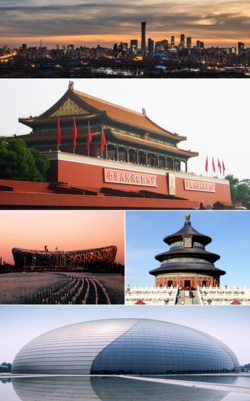Beijing City
|
Beijing 北京市 |
|
|---|---|
| Municipality | |
| Beijing Municipality | |

Clockwise from top: Beijing CBD skyline, Tiananmen, Temple of Heaven, National Center for the Performing Arts, and Beijing National Stadium
|
|
 Location of Beijing Municipality within China |
|
| Coordinates: 39°55′N 116°23′E / 39.917°N 116.383°ECoordinates: 39°55′N 116°23′E / 39.917°N 116.383°E | |
| Country |
|
| Established date | 1046 BC |
| Divisions - County-level - Township-level |
16 districts 289 towns and villages |
| Government | |
| • Type | Municipality |
| • Party Secretary | Cai Qi |
| • Mayor | Chen Jining (acting) |
| • Congress Chairman | Li Wei |
| • Conference Chairman | Ji Lin |
| Area | |
| • Municipality | 16,411 km2 (6,336 sq mi) |
| • Land | 16,801 km2 (6,487 sq mi) |
| • Urban | 1,368 km2 (528 sq mi) |
| • Rural | 15,042 km2 (5,808 sq mi) |
| Elevation | 43.5 m (142.7 ft) |
| Population (2015) | |
| • Municipality | 21,700,000 |
| • Density | 1,300/km2 (3,400/sq mi) |
| • Urban | 18,590,000 |
| • Metro (2010) | 24,900,000 |
| • Ranks in China | Population: 27th; Density: 4th |
| Major ethnic groups | |
| • Han | 95% |
| • Manchu | 2% |
| • Hui | 2% |
| • Mongol | 0.3% |
| • Other | 0.7% |
| Time zone | CST (UTC+8) |
| Postal code | 100000–102629 |
| Area code(s) | 10 |
| GDP(nominal) | 2016 |
| - Total | CNY 2.49 trillion USD 375 billion (13th) |
| - Per capita | CNY 114,742 USD 17,278 (2nd) |
| - Growth |
|
| HDI (2014) | 0.869 (1st)—very high |
| License plate prefixes | 京A, C, E, F, H, J, K, L, M, N, P, Q 京B (taxis) 京G, Y (outside urban area) 京O, D (police and authorities) |
| Abbreviation | BJ / 京 (jīng) |
| City trees | Chinese arborvitae (Platycladus orientalis) |
| Pagoda tree (Sophora japonica) | |
| City flowers | China rose (Rosa chinensis) |
| Chrysanthemum (Chrysanthemum morifolium) | |
| Website | www.ebeijing.gov.cn |
| Beijing | |||||||||||||||||||||||||||||||||||||||

"Beijing" in regular Chinese characters
|
|||||||||||||||||||||||||||||||||||||||
| Chinese | 北京 | ||||||||||||||||||||||||||||||||||||||
|---|---|---|---|---|---|---|---|---|---|---|---|---|---|---|---|---|---|---|---|---|---|---|---|---|---|---|---|---|---|---|---|---|---|---|---|---|---|---|---|
| Postal | Peking Peiping (1368–1403; 1928–1937; 1945–1949) |
||||||||||||||||||||||||||||||||||||||
| Literal meaning | "Northern Capital" | ||||||||||||||||||||||||||||||||||||||
|
|||||||||||||||||||||||||||||||||||||||
| Transcriptions | |
|---|---|
| Standard Mandarin | |
| Hanyu Pinyin | Běijīng |
| Gwoyeu Romatzyh | Beeijing |
| Wade–Giles | Pei3-ching1 |
| IPA | [pèi.tɕíŋ] |
| Wu | |
| Suzhounese | Poh-cin |
| Hakka | |
| Romanization | Bet5-gin1 |
| Yue: Cantonese | |
| Yale Romanization | Bākgīng |
| IPA | [pɐ́k̚.kéŋ] |
| Jyutping | Bak1-ging1 |
| Southern Min | |
| Hokkien POJ | Pak-kiaⁿ |
| Tâi-lô | Pak-kiann |
| Eastern Min | |
| Fuzhou BUC | Báe̤k-gĭng |
Beijing, (/beɪˈdʒɪŋ/)formerly romanized as Peking, is the capital of the People's Republic of China and the world's second most populous city proper and most populous capital city. The city, located in northern China, is governed as a direct-controlled municipality under the national government with 16 urban, suburban, and rural districts. Beijing Municipality is surrounded by Hebei Province with the exception of neighbouring Tianjin Municipality to the southeast; together the three divisions form the Jingjinji metropolitan region and the national capital region of China.
As a city combining both modern and traditional architecture, Beijing is an ever-changing megacity rich in history but also truly modern, exemplified in its global influence in politics, business & economy, education, history, culture, language, music, sporting, architecture, civilization, fashion, art, entertainment, innovation, and technology. Beijing is the second largest Chinese city by urban population after Shanghai and is the nation's political, cultural, and educational center. It is home to the headquarters of most of China's largest state-owned companies and is a major hub for the national highway, expressway, railway, and high-speed rail networks. The Beijing Capital International Airport has been the second busiest in the world by passenger traffic since 2010, and, as of 2016[update], the city's subway network is the busiest and second longest in the world, after Shanghai's subway system.
...
Wikipedia
